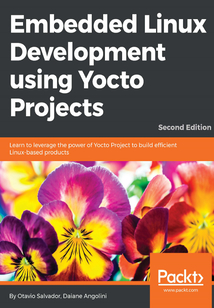舉報 

會員
Embedded Linux Development using Yocto Projects(Second Edition)
最新章節:
Summary
IfyouareanembeddedLinuxdeveloperwithabasicknowledgeofYoctoProjectandwanttobroadenyourknowledgewithexamplesofembeddeddevelopment,thenthisbookisforyou.ThisbookisalsoforprofessionalswhowanttofindnewinsightsintoworkingmethodologiesforLinuxdevelopment.
目錄(170章)
倒序
- coverpage
- Title Page
- Embedded Linux Development using Yocto Projects
- Second Edition
- Copyright
- Embedded Linux Development using Yocto Projects
- Second Edition
- Credits
- About the Authors
- About the Reviewer
- www.PacktPub.com
- Why subscribe?
- Customer Feedback
- Preface
- What this book covers
- What you need for this book
- Who this book is for
- Conventions
- Reader feedback
- Customer support
- Downloading the color images of this book
- Errata
- Piracy
- Questions
- Meeting the Yocto Project
- What is the Yocto Project?
- Delineating the Yocto Project
- Understanding Poky
- Using BitBake
- OpenEmbedded-Core
- Metadata
- The alliance of the OpenEmbedded Project and the Yocto Project
- Summary
- Baking Our Poky-Based System
- Configuring a host system
- Installing Poky on Debian
- Installing Poky on Fedora
- Downloading the Poky source code
- Preparing the build environment
- Knowing the local.conf file
- Building a target image
- Running images in QEMU
- Summary
- Using Toaster to Bake an Image
- What is Toaster?
- Installing Toaster
- Starting Toaster
- Building an image to QEMU
- Summary
- Grasping the BitBake Tool
- Understanding the BitBake tool
- Exploring metadata
- Parsing metadata
- Dependencies
- Preferring and providing recipes
- Fetching the source code
- Remote file downloads
- Git repositories
- Optimizing the source code download
- Disabling network access
- Understanding BitBake's tasks
- Extending tasks
- Generating a root filesystem image
- Summary
- Detailing the Temporary Build Directory
- Detailing the build directory
- Constructing the build directory
- Exploring the temporary build directory
- Understanding the work directory
- Understanding the sysroot directories
- Summary
- Assimilating Packaging Support
- Using supported package formats
- List of supported package formats
- Choosing a package format
- Running code during package installation
- Understanding shared state cache
- Explaining package versioning
- Specifying runtime package dependencies
- Package feeds
- Using package feeds
- Summary
- Diving into BitBake Metadata
- Using metadata
- Working with metadata
- The basic variable setting
- Variable expansion
- Setting a default value using ?=
- Setting a default value using ??=
- Immediate variable expansion
- Appending and prepending
- Override syntax operators
- Conditional metadata set
- Conditional appending
- File inclusion
- Python variable expansion
- Defining executable metadata
- Defining Python functions in the global namespace
- The inheritance system
- Summary
- Developing with the Yocto Project
- Deciphering the software development kit
- Working with the Poky SDK
- Using an image-based SDK
- Generic SDK – meta-toolchain
- Using an SDK
- Developing applications on the target
- Integrating with Eclipse
- Summary
- Debugging with the Yocto Project
- Differentiating metadata and application debugging
- Tracking image package and SDK contents
- Debugging packaging
- Logging information during task execution
- Utilizing a development shell
- Using the GNU Project Debugger for debugging
- Summary
- Exploring External Layers
- Powering flexibility with layers
- Detailing the layer's source code
- Adding meta layers
- The Yocto Project layer ecosystem
- Summary
- Creating Custom Layers
- Making a new layer
- Adding metadata to the layer
- Creating an image
- Adding a package recipe
- Automatically creating a base package recipe using recipetool
- Adding support to a new machine definition
- Wrapping an image for your machine
- Using a custom distribution
- MACHINE_FEATURES versus DISTRO_FEATURES
- Understanding the variables scope
- Summary
- Customizing Existing Recipes
- Common use cases
- Adding extra options to recipes based on Autoconf
- Applying a patch
- Adding extra files to the existing packages
- Understanding file searching paths
- Changing recipe feature configuration
- Customizing BusyBox
- Customizing the linux-yocto framework
- Summary
- Achieving GPL Compliance
- Understanding copyleft
- Copyleft compliance versus proprietary code
- Some guidelines for license compliance
- Managing software licensing with Poky
- Commercial licenses
- Using Poky to achieve copyleft compliance
- License auditing
- Providing the source code
- Providing compilation scripts and source code modifications
- Providing license text
- Summary
- Booting Our Custom Embedded Linux
- Exploring the boards
- Discovering the right BSP layer
- Baking for the hardware
- Baking for BeagleBone Black
- Baking for Raspberry Pi 3
- Baking for the Wandboard
- Booting our baked image
- Booting BeagleBone Black from the SD card
- Booting Raspberry Pi 3 from the SD card
- Booting Wandboard from the SD card
- Next steps
- Summary 更新時間:2021-07-02 15:09:05
推薦閱讀
- 機器學習實戰:基于Sophon平臺的機器學習理論與實踐
- 基于C語言的程序設計
- 集成架構中型系統
- Introduction to DevOps with Kubernetes
- Cloud Analytics with Microsoft Azure
- PyTorch深度學習實戰
- Zabbix Network Monitoring(Second Edition)
- ROS機器人編程與SLAM算法解析指南
- 21天學通Visual C++
- Ceph:Designing and Implementing Scalable Storage Systems
- JavaScript典型應用與最佳實踐
- Docker on Amazon Web Services
- Bayesian Analysis with Python
- 筆記本電腦使用與維護
- Advanced Deep Learning with Keras
- 工業機器人編程指令詳解
- 細節決定交互設計的成敗
- 我的IT世界
- 面向Agent的軟件設計開發方法
- 從零開始學Visual C++
- Robust Cloud Integration with Azure
- DevOps:Puppet,Docker,and Kubernetes
- 信息安全技術與實施
- Internet應用考前12小時
- UGNX 5三維造型
- Installation,Storage,and Compute with Windows Server 2016:Microsoft 70-740 MCSA Exam Guide
- Do more with SOA Integration:Best of Packt book
- Machine Learning with R
- 移動機器人導航定位技術
- 人人可懂的數據科學

